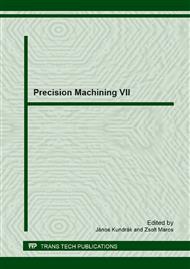p.68
p.77
p.82
p.89
p.95
p.100
p.106
p.112
p.119
Machining of Non-Homogeneous Composite Material with Natural Fibers Reinforcement and HDPE Matrix
Abstract:
Depending on expanding population and its increasing purchasing power we are forced to use more and more renewable resources for a production of materials. When compared to other types of fibres, the natural fibres have a lot of advantages: they are affordable (only 1/10 of a glass fibre price), non-abrasive, recyclable, with relatively high strength and rigidity, low density (and low weight in hollow profiles). When combined with plastic matrix the exceptional biomaterial, which is possible to describe as friendly environment, is created. It has high potential to succeed with a final customer. At present, a use of thermoplastic matrices (especially with WPC materials) is preferred. The final subject of this article is to point out considerable disadvantage from a perspective of machining inhomogeneity of the material (in full profiles).
Info:
Periodical:
Pages:
95-99
Citation:
Online since:
October 2013
Authors:
Keywords:
Price:
Сopyright:
© 2014 Trans Tech Publications Ltd. All Rights Reserved
Share:
Citation:


